Essay: On my feathered friends
Close your eyes and listen to the sounds around you
Close your eyes and listen to the sounds around you. What do you hear? Can you hear the birds? If you can’t, picture a bird in front of you. Imagine you can see two birds, three birds, four birds. Imagine a group of birds sitting together. What do you see? You are probably imagining a pigeon, a crow or a myna and thinking of the sounds they make. What if I told you to imagine a rufous treepie, a magpie robin, a brown headed barbet, a kingfisher or a sunbird? Now, you are probably picturing yourself in a bird sanctuary. What if I told you to imagine all these birds perched on trees in a South Delhi neighbourhood? What if I told you that these birds are all around, even if you don’t always notice them? All you need to do is open your eyes and look. Our feathered friends are waiting to be seen.
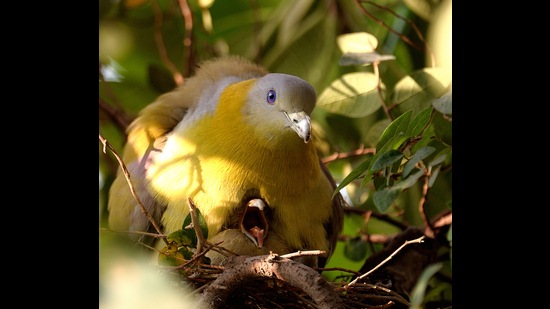
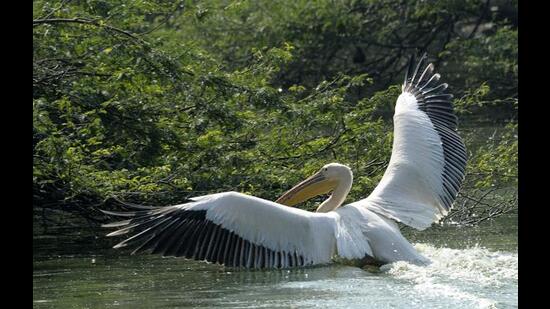
I started photography at the tender age of nearly 50. So I was in a hurry; I had to learn everything and make up for all the years I had missed. I was enamoured by photos of beautiful bird, especially ones of birds in flight. I began to wake up early every morning and go to my terrace before anyone else stirred in the house. I wanted to observe birds and photograph them. I was astonished by the many species of birds that visited my home in South Delhi, across the seasons and at various times of the day. I took as many pictures as I could and spent the day editing them on my computer. I had absolutely no idea what these beautiful birds were called. I clicked a rufous treepie perched on the satellite dish on my terrace and labelled it, ‘the mustard bird with a long tail’. A photo of silverbills was named, ‘sparrows with a shiny beak’. Now, after a decade of photographing these beautiful creatures and clicking more than 40 species from the terrace of my home alone, I have taught myself their real names. My camera has opened my eyes to a brand new world around me.
Most people think pigeons, crows and mynas are boring and common. They complain about how they dirty our terraces, our balconies and our public spaces and about the noise they make. I wish they could see the beautiful eyes of the common myna like I do through my camera lens. They would find them a lot more interesting then. Which isn’t to say birds aren’t noisy; they are my natural alarms. On most days, they wake me up by knocking on my window glass. I like to think that they want me to come out and take a photo of them while they’re still looking their best, early in the morning. I have even learnt to appreciate pigeon poop although that is a result of my other passion – gardening. Good pigeon poop, although unpleasant to look at, is an excellent fertiliser and a source of phosphorous for my plants.

Seeing things through my camera lens has given me a superpower. I suddenly see so much more than just the greys, the blacks and the browns. I see the bright purple of the sunbirds, the vibrant green of the brown-headed barbet, the bright blue of the kingfishers, the golden yellow of the oriole - colours I wonder how I missed earlier, especially when they were perched on trees and electric wires all around me. These birds come in different sizes. Some are small enough to fit in my palm, some are bigger than a football, others are bigger still. Once I began really seeing birds, I started listening to them too. Mother Nature does everything for a purpose. The males of most species have sweeter voices than the females. In most cases, they have brighter colours too. I realised only recently that a bird’s appearance and colour can change with the seasons. Its plumage during the mating season is much more colourful and attractive than it is during the rest of the year. I have been witness to numerous young suitors attempting to lure prospective partners by showing off their dancing skills and offering them good food, usually with great success (not unlike us humans). One morning, as I was admiring a bright green brown headed barbet perched on a tree, another one arrived with an orange fruit in its beak. It solemnly gifted the fruit to the other, and the two birds mated.
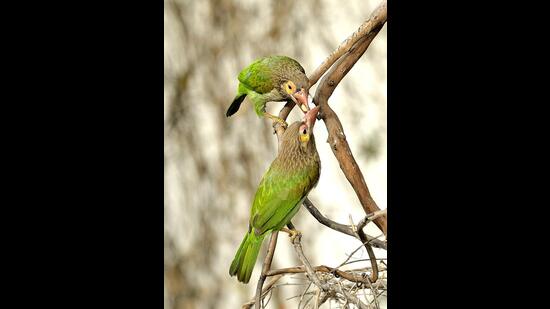
I have experienced many sweet and enjoyable moments with different birds in the course of my photography and would love to share a few of these instances as anecdotes. I say anecdotes because some portion stems from my imagination. However, these are true representations of my experience, and I leave it to you to decide whether they ring true for you too.
I do not encourage photographing birds when they are nesting. It disturbs them, which could endanger their eggs or their babies. But what do you do when a family of birds knocks at your door and insists on modelling for you? One summer afternoon, I was amazed to see a pair of eyes peeping out from behind a bush in my garden. When I went up for a closer look, I saw that a mother peahen and her four beautiful chicks had come unannounced to my house. They made my garden their home for a week. The seven days when they were my honoured guests (and unpaid models) are among the most beautiful memories of my life. The little family wandered freely around my house and garden everyday as I clicked hundreds of photos of them from sunrise to sunset.
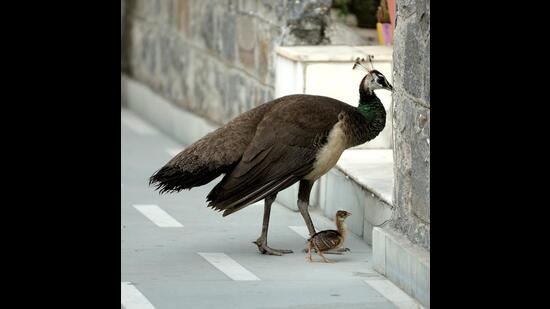
I watched mother peahen discipline her chicks when they were naughty. I observed her protectiveness when she feared that a visiting crow had less than honourable intentions towards her babies. I saw her patiently teach them to fly, one stair at a time. To her credit, it took them only a week to fly up to the balcony on the first floor. When mother Peahen took her babies under her wings towards the end of the day, I was reminded of my own childhood and of my mother shutting all the doors and turning off all the lights before putting myself, my brother and my sister to bed. The peahen and her family flew away soon after the chicks learnt to fly, but not before they had polished off all the tender tomato and spinach plants from my kitchen garden. I thought it was a very fair exchange for all the joy they had brought me during their stay.
Another year and another nesting season later, a yellow footed green pigeon made its home on a tree in my garden. I clicked thousands of pictures of the mother, father and the cute baby bird as they happily modelled for me. Sadly, only one of their many eggs survived. I captured their happiness and their scares. The cuddles between mama and baby pigeon, lazy yawns as the baby woke up in the morning, the time a rufous treepie attacked the baby pigeon. This last incident was scary for the birds and for me too. Father pigeon rarely went far from the nest but on this particular day, he was nowhere to be seen. However, mama pigeon took over and a fierce fight ensued between the gentle, loving mama and the villainous rufous treepie. I nervously photographed the fight, rooting for her to win. For a moment it looked like she was going to be defeated. I couldn’t hold myself back and stepped in to help her fight the villain and chase him away. Over the next few days, mama pigeon kept a close watch on her baby but from a distance so he had space to grow. Inevitably, one day when the baby’s wings were strong enough, the pigeon family took off and I found the nest empty the next morning when I came to visit.
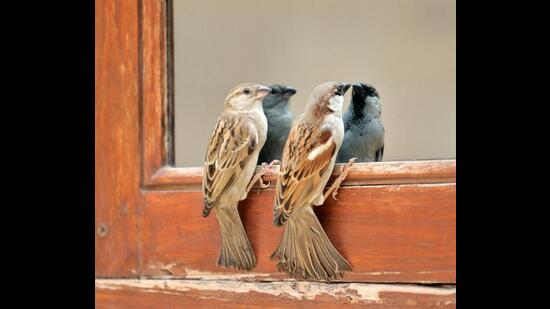
Many people think that bird photography is just a game of patience, or a game of luck. They think that if you’re at the right place at the right time, you’ll take a beautiful picture as a matter of course. While luck and patience definitely have a role to play in creating a beautiful photograph, there is a lot more to it. You need good light for which you need to be awake early - with the birds as they say - and be at a spot you know they’ll visit, well before they arrive. In the morning, not only do you benefit from better light and the absence of harsh shadows, but the birds themselves are at their most active and you can capture them as they go about their daily activities. The composition of a photograph has to be interesting, even though the subject is interesting in itself. Technical rules such as the rule of thirds and other rules of composition play as big a role as they do in other genres of photography. The background is critical as well. You can’t force a bird to perch in a particular position but placing yourself in a specific position might help you get a good picture. As in a human portrait, I prefer to focus on the bird, and not too much on the background. I play with the depth of field to attain that. Reflections of birds in water, particularly at sunrise, can create surreal effects. Bird silhouettes are also beautiful. One evening, I spent almost an hour waiting for the sun’s rays to reach a specific point on a tree where a red vented bulbul was perched. The silhouette of the bird completely changed the landscape I was trying to photograph. I prayed that the bird wouldn’t fly off while I watched the sun go down bit by bit.
I have been photographing birds for more than a decade now. I have enjoyed every moment of this journey and all the places it has taken me. It has introduced me to black swans in Australia, rheas in the Ibera Wetlands of Argentina, sarus cranes in Bharatpur, flamingoes in Gujarat and even the very common jungle babbler in my garden. On this journey, I have developed a real love for these beautiful, friendly subjects. I continue to photograph them because I love them, and not just because they make an interesting photograph. I like to think that they share this love, that they enjoy posing for me, and that they think of me as a friend and not a stalker.
Prerna Jain’s book, ‘My Feathered Friends’, is available on Amazon.
All Access.
One Subscription.
Get 360° coverage—from daily headlines
to 100 year archives.



HT App & Website






